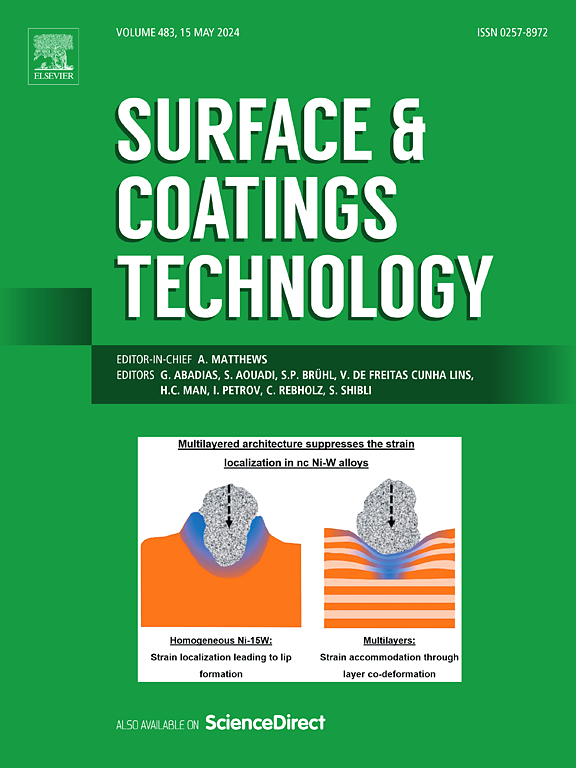Microstructure and dielectric properties of Al₂O₃–Cr₂O₃ composite coatings fabricated by wide-velocity range high-energy plasma spraying
IF 5.3
2区 材料科学
Q1 MATERIALS SCIENCE, COATINGS & FILMS
引用次数: 0
Abstract
The presence of γ-phase in alumina (Al2O3) coatings has been widely acknowledged as a detrimental factor compromising dielectric performance, presenting a longstanding challenge in advanced coating design. To overcome this limitation, a series of Al2O3-Cr2O3 composite coatings were fabricated by wide-velocity range high-energy plasma spraying (WPS) in this study. The systematic investigation of chromium oxide (Cr2O3) doping effects on dielectric properties of as-sprayed coatings was conducted through dielectric breakdown tests. The results suggested that the incorporation of Cr2O3 effectively reduced porosity and increased α-Al2O3 content in all the as-sprayed coatings. Compared to pure Al2O3 coatings, the Al2O3-Cr2O3 composite coatings exhibited significantly lower porosity and higher α-Al2O3 content. There is a marked decrease of porosity (1.3–1.7 %) occurred when the Cr2O3 concentration increased to 4 % and 8 %. Notably, the α-Al2O3 content reached a maximum of 53.2 % at 4 wt% Cr2O3 incorporation, while the coating with 8 wt% Cr2O3 showed the highest breakdown voltage (35.2 V/μm), representing a 7.8 V/μm improvement (28.5 % increase from 27.4 V/μm for pure Al2O3) due to its high α-Al2O3 content and low porosity (4 %). Although various studies have addressed the retention of the α-Al2O3 in thermally sprayed Al2O3 coatings, achieving a balance between the α-Al2O3 and porosity remains a crucial challenge. Our findings provide valuable insights for the development of high-performance plasma-sprayed Al2O3-based insulating coatings, offering a viable pathway to enhance dielectric properties through controlled phase composition and microstructure engineering simultaneously.
宽速度范围高能等离子喷涂Al₂O₃-Cr₂O₃复合涂层的微观结构和介电性能
氧化铝(Al2O3)涂层中γ相的存在已被广泛认为是影响介电性能的有害因素,这是先进涂层设计的一个长期挑战。为了克服这一限制,本研究采用宽速度范围高能等离子喷涂(WPS)制备了一系列Al2O3-Cr2O3复合涂层。通过介质击穿试验,系统研究了氧化铬(Cr2O3)掺杂对喷涂涂层介电性能的影响。结果表明,Cr2O3的加入能有效降低涂层的孔隙率,提高涂层中α-Al2O3的含量。与纯Al2O3涂层相比,Al2O3- cr2o3复合涂层孔隙率显著降低,α-Al2O3含量显著提高。当Cr2O3浓度增加到4%和8%时,孔隙率明显降低(1.3 ~ 1.7%)。值得注意的是,当Cr2O3掺入量为4 wt%时,α-Al2O3含量达到53.2%,而当Cr2O3掺入量为8 wt%时,涂层的击穿电压最高(35.2 V/μm),由于其α-Al2O3含量高,孔隙率低(4%),击穿电压比纯Al2O3的27.4 V/μm提高了7.8 V/μm(28.5%)。尽管各种研究已经解决了α-Al2O3在热喷涂Al2O3涂层中的保留问题,但实现α-Al2O3和孔隙率之间的平衡仍然是一个关键的挑战。我们的研究结果为高性能等离子喷涂al2o3基绝缘涂层的开发提供了有价值的见解,为通过控制相组成和微观结构工程同时提高介电性能提供了可行的途径。
本文章由计算机程序翻译,如有差异,请以英文原文为准。
求助全文
约1分钟内获得全文
求助全文
来源期刊

Surface & Coatings Technology
工程技术-材料科学:膜
CiteScore
10.00
自引率
11.10%
发文量
921
审稿时长
19 days
期刊介绍:
Surface and Coatings Technology is an international archival journal publishing scientific papers on significant developments in surface and interface engineering to modify and improve the surface properties of materials for protection in demanding contact conditions or aggressive environments, or for enhanced functional performance. Contributions range from original scientific articles concerned with fundamental and applied aspects of research or direct applications of metallic, inorganic, organic and composite coatings, to invited reviews of current technology in specific areas. Papers submitted to this journal are expected to be in line with the following aspects in processes, and properties/performance:
A. Processes: Physical and chemical vapour deposition techniques, thermal and plasma spraying, surface modification by directed energy techniques such as ion, electron and laser beams, thermo-chemical treatment, wet chemical and electrochemical processes such as plating, sol-gel coating, anodization, plasma electrolytic oxidation, etc., but excluding painting.
B. Properties/performance: friction performance, wear resistance (e.g., abrasion, erosion, fretting, etc), corrosion and oxidation resistance, thermal protection, diffusion resistance, hydrophilicity/hydrophobicity, and properties relevant to smart materials behaviour and enhanced multifunctional performance for environmental, energy and medical applications, but excluding device aspects.
 求助内容:
求助内容: 应助结果提醒方式:
应助结果提醒方式:


